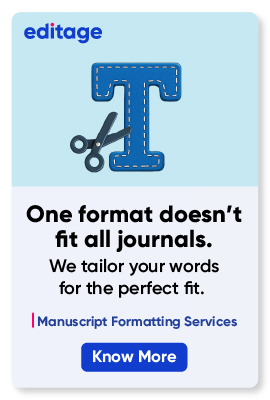How to Format Manuscripts for Open Access Journals

Over the years, open access (OA) journals have steadily become popular among researchers and scientists around the world. Here’s a succinct guide on how to format a manuscript for open access journals.
Formatting Guidelines for Open Access Journals
Open access journals do not specify any length restrictions for a standard manuscript format. But it is important that you maintain a logical flow when discussing your findings.
Organize your manuscript into following sections to maintain uniformity and to adhere to the standard format recommended by open access journals:
Title
Begin your paper with a concise title that is easily understood by readers outside of your field. It is better to avoid uncommon abbreviations. Write it in title case, with the first letters of all words—except articles, prepositions, and conjunctions—capitalized. Open access journals also require you to provide a running title of approximately 40 characters.
Authors & Affiliations
Next, mention the names of all contributing authors (first name, middle name, and surname) along with their corresponding affiliations. These details should include the department, university or organization name, city, state/province (if applicable), and country.
Don’t forget to identify the corresponding author and provide relevant contact information!
Abstract
Open access journals require you to provide structured abstracts, with the following sub-headings: Title, Background, Methods and Findings, and Conclusions.
- Title: Introduce your study.
- Background: Present a clear rationale for conducting the research and this section with the study objectives.
- Methods and Findings: Explain the study design or the main methods used for the analysis. You can include participant details and how the results were analyzed. Any numerical results can be highlighted here along with adverse side effects, if any.
- Conclusions: Interpret your findings and summarize the potential future scope.
Introduction
Describe the purpose of your study in a broad context, keeping in mind those readers who are not experts in the field. After reviewing key literature, highlight any relevant discrepancies that the readers can investigate further. Towards the end of the section, include the aim of the study and specify whether it was achieved.
Methods
Herein, explain the methodology implemented for your analysis, providing enough detail for other researchers to be able to reproduce your findings. You may discuss the different testing techniques, protocols, or statistical methods employed. Be sure to include all participant details under this section, if applicable.
Results
This section should present both positive and negative findings that are relevant to your study. Feel free to divide the section into appropriate sub-sections to present your findings in a logical manner.
Use the past tense to report your findings and include tables, figures, graphs, or any other suitable illustrations that might be useful to present your findings.
Discussion
This will be the final section of your main text. You can start with a summary of the main study findings, followed by the implications, strengths, and limitations of the study.
Discuss the following key points:
- How do the study conclusions impact the existing knowledge?
- What are the potential future lines of investigation?
- Do you recommend any key experiments that must be conducted?
Remember, your observations and conclusions should provide a firm foundation for future research in the field.
References
Open access journals follow the guidelines provided by the International Committee of Medical Journal Editors (ICMJE) for reference formatting. This means that your reference list should be numbered consecutively in the order of their appearance in the main text. For details on how each reference should be cited, you can refer NLM’s sample references.
Acknowledgements
Finally, you need to acknowledge all those who contributed to your work but did not fit the criteria for authors. Make sure you obtain their permission before including their names in the acknowledgments.
The funding details should be mentioned separately in a funding statement. So do not include them here.
Figure Legends
Figure legends must not exceed 15 words. Keep them succinct and self-sufficient, explaining all symbols and abbreviations such that the readers can understand the figure without having to refer to the main text.
Table Captions
Similar to figure legends, provide table captions that are concise and to the point. Avoid lengthy descriptions in both figure legends and table captions.
General Submission Guidelines for Open Access Journals
Here are other submission guidelines to keep in mind for open access journal submission:
1. Make sure the content of your manuscript is original and not under consideration by other publishers or journals.
2. Upload all tables and figures separately during the submission process.
3. Declare any competing interests, both financial and non-financial, during the submission process to help maintain transparency during peer review.
4. Provide funding information in a separate funding statement. If applicable, you should identify the role of sponsors in study design, data collection, data analysis, and manuscript preparation.
5. Adhere to all ethical guidelines, especially if your study involves animal and human subjects. Note that informed consent is a MUST in the latter case.
6. Open access journals encourage data sharing to enhance the peer review process and increase the chances of accurate reproducibility of the study. This can not only improve citations of your paper but also result in better funding opportunities in the future.
Give more time for your research, spend less time formatting! Check out Editage’s Manuscript Formatting Services and get professional support for journal formatting.






